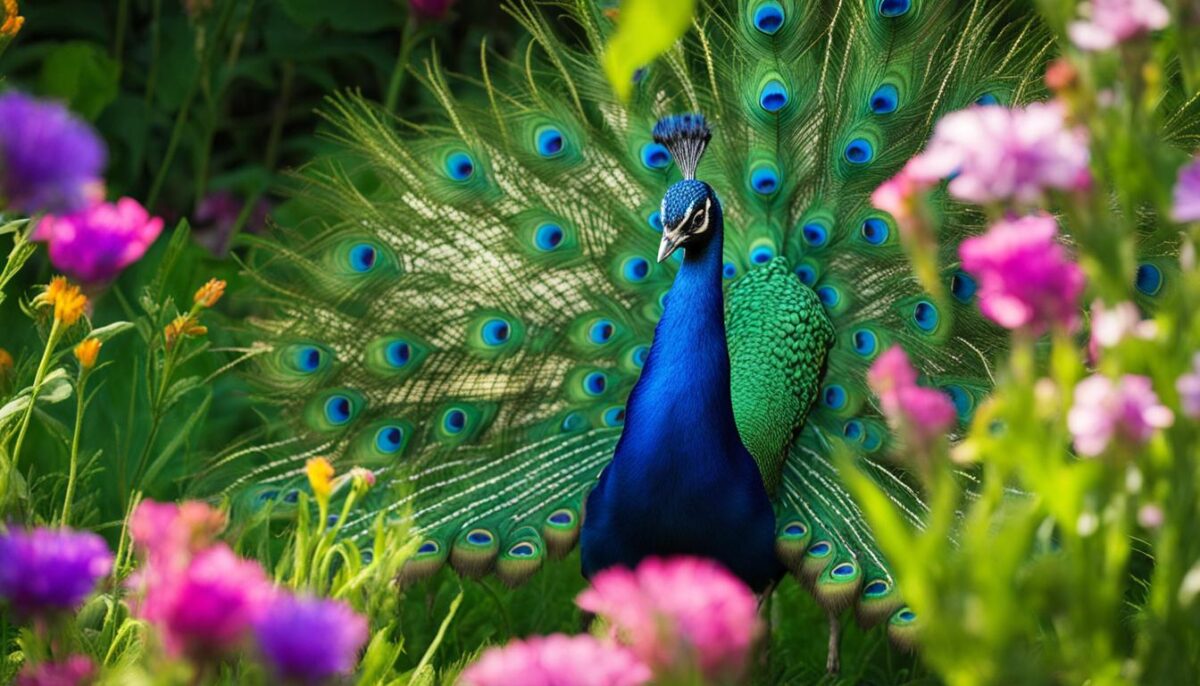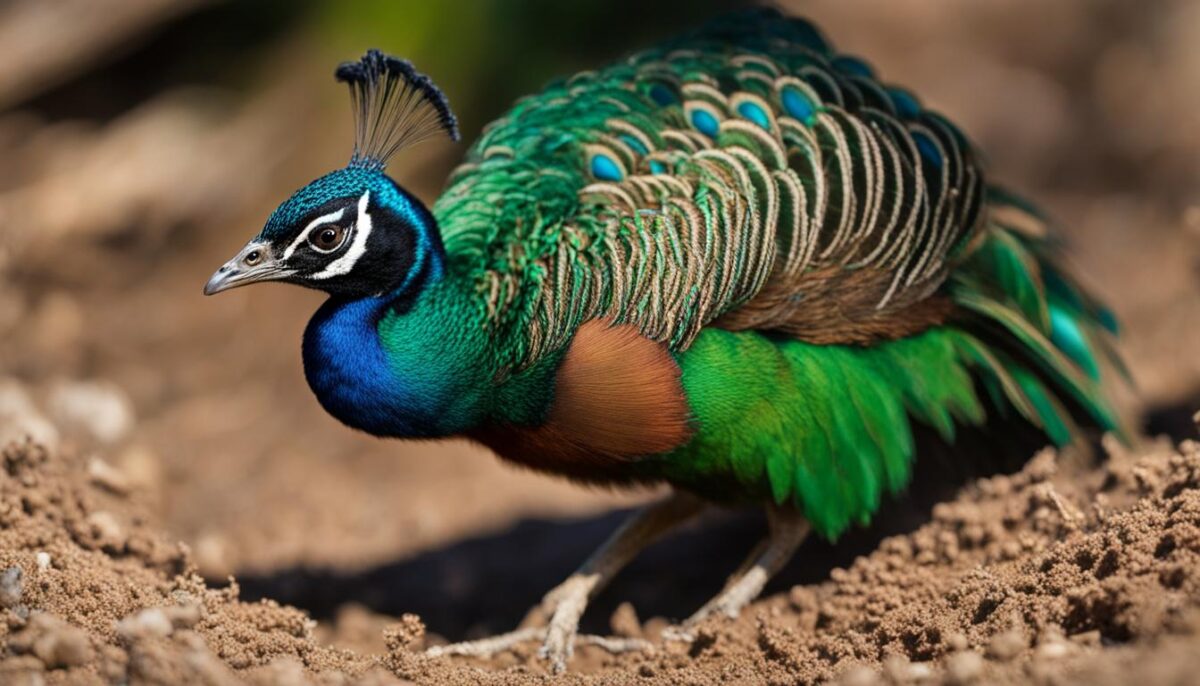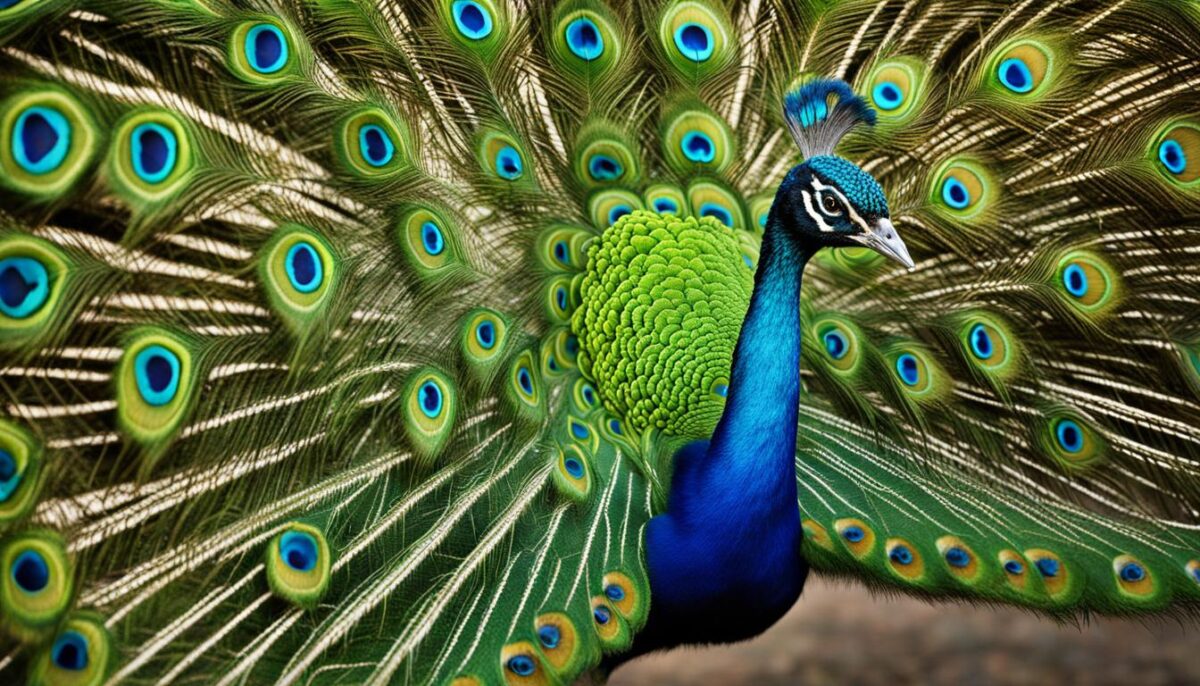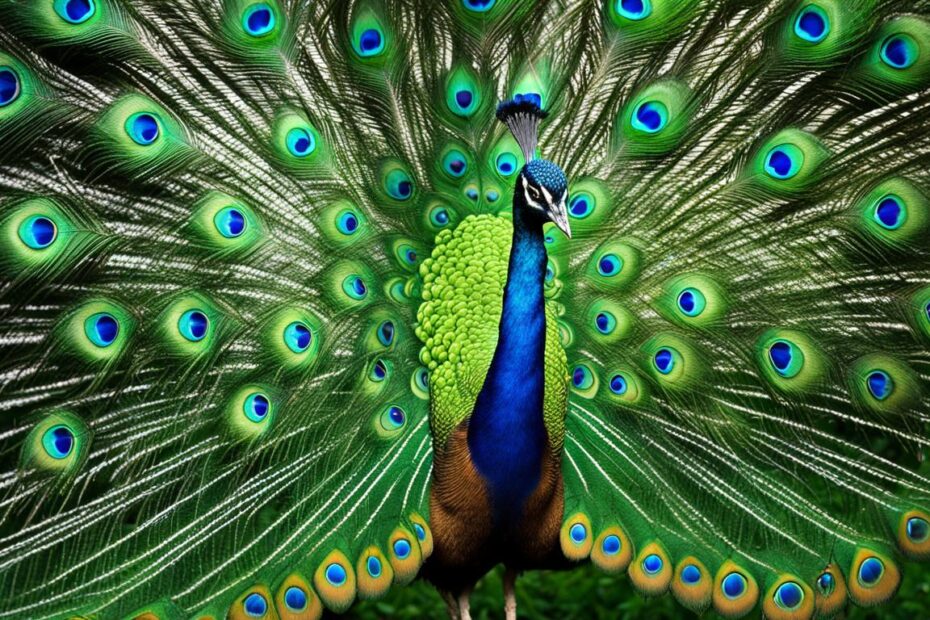Peacocks, also known as peafowl, are magnificent birds that belong to the pheasant family, specifically the Phasianidae family. There are three species of peafowl, including the blue peacock (Pavo cristatus), the green peacock (Pavo muticus), and the Congo peacock (Afropavo congensis). The males are called peacocks, the females are peahens, and the babies are peachicks. These birds are known for their vibrant and beautiful plumage, with the males displaying dramatic and colorful feathers to attract mates. Peacocks have a unique lifecycle and fascinating behaviors that make them a true wonder of nature.
Key Takeaways
- Male baby peacocks, or peacock chicks, have less vibrant plumage compared to adult males.
- The lifecycle of a male baby peacock starts with egg-laying by the female peahen.
- Male baby peacocks exhibit social behavior similar to adult peafowls.
- The diet of male baby peacocks consists of insects, plants, and small creatures.
- Male baby peacocks inhabit various habitats, including forests, farms, and urban areas.
The Appearance of Male Baby Peacocks
Male baby peacocks, also known as peacock chicks or male pea chicks, have a distinctive appearance that sets them apart from their female counterparts. Unlike adult male peacocks, whose feathers are vibrant and colorful, the plumage of young male peacocks is less flamboyant. Instead, their feathers are more subdued in shades of brown, beige, and cream. This muted coloration helps them blend into their surroundings and provides camouflage, offering protection from predators.
As male baby peacocks mature, their plumage gradually develops the characteristic bold and iridescent colors for which adult male peacocks are famous. It takes about two years for them to fully display their mature coloring. During this time, their feathers undergo a remarkable transformation, becoming vibrant blues, greens, and bronzes. The long, extravagant train feathers, which are a trademark of adult male peacocks, also begin to grow. These train feathers can reach up to six feet in length and are used during courtship displays to attract females.
Male baby peacocks may not be as eye-catching as their adult counterparts, but their gradual transformation into magnificent creatures is truly awe-inspiring. From their humble beginnings as chicks, they grow to become nature’s colorful wonders, captivating us with their beauty and charm.
The Lifecycle of Male Baby Peacocks
The lifecycle of a male baby peacock is a fascinating journey that begins with the egg-laying process by the female peahen. During the breeding season, the peahen lays one egg per day for about eight days. These eggs are incubated by the peahen for a period of 28 to 30 days. Once hatched, the peachicks are able to walk and forage on their own immediately.
Male baby peacocks, like their female counterparts, are vulnerable and have a high mortality rate. Only a few chicks survive to adulthood, facing various challenges as they grow. Interestingly, male peacock chicks do not display their mature coloring until their second year. This means that during their first year of life, they have more subdued coloration, exhibiting a combination of brown, beige, and cream feathers.
As they mature and reach their second year, their plumage gradually develops the characteristic bold and iridescent colors for which adult male peacocks are known. It is during this time that they also begin to exhibit the extravagant courtship displays that attract their potential mates. The lifecycle of a male baby peacock is a testament to the wonders of nature and the incredible transformation these birds undergo.

The Vulnerability of Male Baby Peacocks
Male baby peacocks experience a period of vulnerability during their early stages of life. With a high mortality rate, only a few chicks survive to adulthood. Factors such as predation, disease, and environmental conditions contribute to their vulnerability. These challenges are part of the natural selection process, ensuring that only the fittest individuals reach maturity and pass on their genes.
The Importance of Survival Strategies
Male baby peacocks employ various survival strategies to increase their chances of reaching adulthood. They rely on their camouflaged plumage to blend in with their surroundings, making it harder for predators to spot them. Additionally, their ability to quickly learn and adapt to their environment helps them navigate potential dangers and find sources of food and shelter.
| Survival Strategies of Male Baby Peacocks | Explanation |
|---|---|
| Hiding in vegetation | Male baby peacocks use their natural surroundings to conceal themselves from predators, blending in with the vegetation for protection. |
| Mimicking behaviors | They observe and mimic the behaviors of their parents and other adult peafowls to learn survival techniques and social interactions. |
| Group foraging | Male baby peacocks often forage in small groups, increasing their chances of finding food and staying safe from predators. |
These survival strategies are essential for the male baby peacocks to navigate the challenges they face during their early stages of life. By employing these strategies and successfully reaching adulthood, they contribute to the continuation of their species and the preservation of their remarkable beauty.
The Social Behavior of Male Baby Peacocks
Male baby peacocks, or peacock chicks, exhibit social behavior similar to their adult counterparts. They are social creatures, often spending their mornings in small groups, foraging on the ground for food. During the non-breeding season, these groups are usually all-male or all-female. However, during the breeding season, there are groups consisting of one male and several females or groups of all-male bachelors.
Male baby peacocks take midday breaks to drink, preen their feathers, and rest in the shade. They rely on the safety of numbers and often roost overnight in large groups in tall trees. This communal behavior helps protect them from predators and provides a sense of comfort and security.
Observing these young peacocks in their social interactions is a captivating sight. Whether it’s watching them forage together or witnessing their stunning display during courtship, their social behavior adds another layer of intrigue to the wonder of male baby peacocks.
Behavior Summary
- Male baby peacocks exhibit social behavior similar to adult peafowls.
- They forage for food in small groups, often all-male or all-female.
- During the breeding season, there are groups with one male and several females or all-male bachelor groups.
- They take midday breaks to drink, preen, and rest in the shade.
- They roost overnight in large groups in tall trees for safety.
“The social behavior of male baby peacocks adds to their allure and provides valuable insights into their natural interactions.”
The Diet of Male Baby Peacocks
Male baby peacocks have a varied and omnivorous diet that plays a crucial role in their growth and development. Their diet consists of a combination of insects, plants, and small creatures.
Insects form a significant part of their diet, and they actively forage for them on the ground. Peacock chicks have a natural instinct to pick at the ground and peck on insects they find, such as beetles, grasshoppers, and ants. Insects provide them with essential protein and nutrients necessary for their feather development and overall health.
In addition to insects, male baby peacocks also consume plants and small creatures. They feed on a variety of greens, including leaves, seeds, and fruits. These plant materials offer them vitamins and minerals that contribute to their nutritional needs. Male baby peacocks may also snack on small creatures like worms or snails, which further diversify their diet.
The diet of male baby peacocks is critical for their feather quality, as it influences the vibrancy and health of their plumage. A balanced and diverse diet ensures that these beautiful birds reach their full potential as they mature into adult male peacocks with their iconic colorful feathers.

The Diet of Male Baby Peacocks:
- Insects: Beetles, grasshoppers, ants
- Plants: Leaves, seeds, fruits
- Small Creatures: Worms, snails
Benefits of a Varied Diet:
“A balanced and diverse diet is crucial for the growth and development of male baby peacocks. It provides them with the necessary nutrients for their feather quality and overall health.” – Dr. Avian Biology
Table: Nutritional Composition of Male Baby Peacock Diet
| Nutrient | Insects | Plants | Small Creatures |
|---|---|---|---|
| Protein | High | Low | Medium |
| Vitamins | Medium | High | Low |
| Minerals | Medium | High | Low |
The Habitat of Male Baby Peacocks
Male baby peacocks, as well as adult peafowls, have a wide range of habitats that they inhabit. These habitats can include open lowland forests, farms, agricultural fields, and even urban areas. They have the ability to adapt to various environments, making them incredibly versatile birds. The specific habitat of male baby peacocks depends on the species they belong to.
The blue peacock, scientifically known as Pavo cristatus, is predominantly found in India and Sri Lanka. They are often seen in open forests and woodlands. The green peacock, or Pavo muticus, is native to Southeast Asia and is found from Myanmar to Java. They prefer the dense forests and grasslands of these regions. The Congo peacock, scientifically known as Afropavo congensis, is found in the Democratic Republic of the Congo and inhabits the forests of this area.
Male baby peacocks have the ability to thrive in both tropical and dry environments. They have adapted to a variety of climates and can be found in different parts of the world. Whether it’s the lush forests of India or the urban areas of Sri Lanka, these magnificent birds have made their homes in diverse habitats, showcasing their resilience and adaptability.

Habitat Comparison Table
| Peacock Species | Habitat |
|---|---|
| Blue Peacock | Open lowland forests, woodlands |
| Green Peacock | Dense forests, grasslands |
| Congo Peacock | Forests |
The Conservation Status of Male Baby Peacocks
Understanding the conservation status of male baby peacocks is crucial for preserving their population and protecting their habitats. Each species of peafowl faces different challenges and require specific conservation efforts.
1. Blue Peacock (Pavo cristatus): The blue peacock is currently listed as “least concern” by the International Union for Conservation of Nature (IUCN). This means that its population is relatively stable, and there are no immediate threats to its survival. Conservation efforts focus on protecting their habitats from deforestation and illegal hunting.
2. Green Peacock (Pavo muticus): The green peacock is considered “endangered” due to habitat loss and overhunting. Their population has significantly declined over the years, and urgent conservation measures are necessary to prevent their extinction. Efforts include establishing protected areas and raising awareness about the importance of preserving their natural habitats.
3. Congo Peacock (Afropavo congensis): The Congo peacock is listed as “vulnerable” by the IUCN with a population of fewer than 10,000 adults. Their numbers are decreasing due to habitat destruction and unsustainable hunting practices. Conservation initiatives focus on habitat restoration and implementing strict regulations on hunting to protect this unique species.
| Peafowl Species | Conservation Status | Population Estimate | Main Threats |
|---|---|---|---|
| Blue Peacock | Least Concern | Stable | Deforestation, illegal hunting |
| Green Peacock | Endangered | Declining | Habitat loss, overhunting |
| Congo Peacock | Vulnerable | Less than 10,000 adults | Habitat destruction, unsustainable hunting |
Conservation efforts for male baby peacocks and their species as a whole are essential to ensure the survival of these magnificent birds and maintain the biodiversity of their ecosystems. By raising awareness, supporting conservation organizations, and implementing sustainable practices, we can contribute to the protection of these iconic creatures for future generations to admire and cherish.
The Lifespan of Male Baby Peacocks
Male baby peacocks, also known as peacock chicks, have a lifespan that can range from 10 to 25 years in the wild. These magnificent birds, with their vibrant colors and striking plumage, captivate us with their beauty and grace. It is fascinating to observe their growth and development, from the moment they hatch to their maturing into adult peacocks. The lifespan of male baby peacocks is influenced by various factors, including habitat, diet, and overall health.
In the wild, male baby peacocks face numerous challenges that can impact their lifespan. Their natural habitat plays a crucial role in their survival. Loss of habitat due to deforestation and urbanization poses a significant threat to these birds. Additionally, factors such as disease, predation, and competition for resources can also affect their longevity. Conservation efforts are essential to protect these birds and ensure their continued existence in the wild.
On the other hand, male baby peacocks that are kept in captivity or domesticated can live even longer. With proper care and nutrition, they can live up to 40 to 50 years. Domesticated peafowls are often found in zoos, sanctuaries, and private collections, where they receive the necessary care and protection. These birds serve as ambassadors for their wild counterparts, raising awareness about their conservation and inspiring awe and admiration in people who encounter them.
| Factors Affecting Lifespan of Male Baby Peacocks | Lifespan Range |
|---|---|
| Habitat and Environmental Factors | 10-25 years |
| Disease and Predation | 10-25 years |
| Diet and Nutrition | 10-25 years |
| Captivity and Domestication | 40-50 years |
As we marvel at the beauty of male baby peacocks, it is important to recognize the significance of their lifespan. By understanding the factors that influence their longevity, we can contribute to their conservation and create a better future for these stunning creatures.

Quick Facts about Male Baby Peacocks:
- Male baby peacocks have a lifespan of 10 to 25 years in the wild.
- Habitat loss, disease, and predation are the main threats to their survival.
- In captivity, male baby peacocks can live up to 40 to 50 years with proper care.
- Conservation efforts are crucial for protecting these magnificent birds.
Conclusion
Male baby peacocks, also known as peacock chicks or male peafowl chicks, are captivating creatures that showcase the wonders of nature. From their distinct appearance to their social behavior and habitat, these young peafowls offer a fascinating glimpse into the diversity and complexity of the natural world.
Although their vibrant plumage and iconic train feathers are yet to develop, male peacock chicks possess a unique charm with their more subdued brown, beige, and cream feathers. As they mature, their colors gradually transform into the bold and iridescent hues that adult male peacocks are famous for.
The lifecycle of a male baby peacock begins with the egg-laying process by the female peahen. These eggs are then incubated for about a month before the peachicks hatch. However, their journey from hatching to adulthood is not an easy one, as survival rates are low and mortality rates are high. Male peacock chicks do not display their mature coloring until their second year.
Male baby peacocks exhibit social behavior that mirrors that of adult peafowls. They form groups for foraging and rest, and during the breeding season, these groups often consist of one male and multiple females or all-male bachelor groups. Additionally, male baby peacocks have a diverse diet, feeding on insects, plants, and small creatures, which contribute to their growth and development.
Understanding and appreciating the life of a male baby peacock allows us to recognize the unique beauty and resilience of these magnificent birds. By supporting conservation efforts and raising awareness about their importance, we can help ensure the continued existence of these remarkable creatures for generations to come.
FAQ
How long does it take for a male baby peacock to develop its colorful feathers?
Male baby peacocks do not display their mature coloring until their second year of life.
How long do male baby peacocks live in the wild?
Male baby peacocks have a lifespan ranging from 10 to 25 years in the wild.
What do male baby peacocks eat?
Male baby peacocks are omnivores and have a varied diet that includes insects, plants, and small creatures.
What is the conservation status of male baby peacocks?
The conservation status of male baby peacocks varies depending on the species. The blue peacock is listed as “least concern,” the green peacock is listed as “endangered,” and the Congo peacock is listed as “vulnerable.”
Where do male baby peacocks live?
Male baby peacocks inhabit various habitats, including open lowland forests, farms, agricultural fields, and even urban areas. They can be found in both tropical and dry environments.


